Back in 2006, I drove on a "White Horse Tour" of the White Horse chalk carvings around Wiltshire. I had intended on doing all eight of these white chalk horses, but time ran out, so I only got to see seven of them (all except Uffington) in 2006. It would be thirteen years later before I would ever see the oldest of the white horses, Uffington White Horse, which I eventually saw this summer. For more information, see my post: Uffington Castle and White Horse. Note that there are two additional white chalk horses in the country; one of these is located near Weymouth in Dorset, and the other is in North Yorkshire. In addition to white horses, there are other chalk figures, such as the Cerne Abbas Giant man (Dorset), Long Man of Wilmington (East Sussex), and many more figures that have since been lost. The oldest figures date from around 1000 B.C., but many have been created much more recently.

The Marlborough White Horse is located near the village of Marlborough in Wiltshire. It is also called the Preshute White Horse, and it is the smallest white horse figure. It was carved into the hillside in 1804, and it is low down on the hillside and obstructed by trees from some views. It can also be seen from the village. It was carved by a group of boys from the High Street Academy, which was a school, based on the design by pupil William Canning whose family owned the land and manor here. It was a yearly tradition to re-scour the design. The school closed in the 1830s, and one of the original scourers ensured that it was repaired in the 1860s after its neglect. The figure has grown thinner, and it was in need of more care in the early 2000s. Marlborough College does pay tribute to it in one of their college songs.
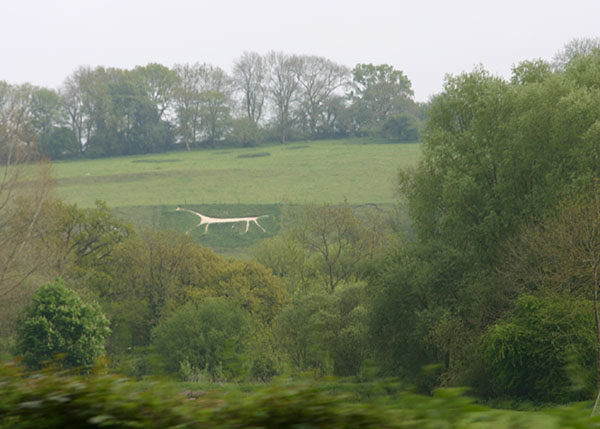
Marlborough White Horse
Broad Town White Horse is located near Broad Town in Wilstshire, and it was a little difficult to locate and in a remote area, which has given it the nickname "the secret white horse". The origin of it is unknown, but it was thought to have been carved by William Simmonds in 1864 who owned the farm then. He'd planned to make it larger, but it never happened. Others claim that they helped scour the horse in 1863 and were told that it was created fifty years earlier, but this may have been confused with one of the other white horses. Another story claims that the horse was cut in 1895 as a tribute to the birth of Prince George and celebrations related to his birth. The horse was covered during World War II, and it was not in good shape when it was uncovered in 1945. The horse was not maintained until 1991, and the people in the town now look after it, though it looked like it needed some love when I visited in 2006.
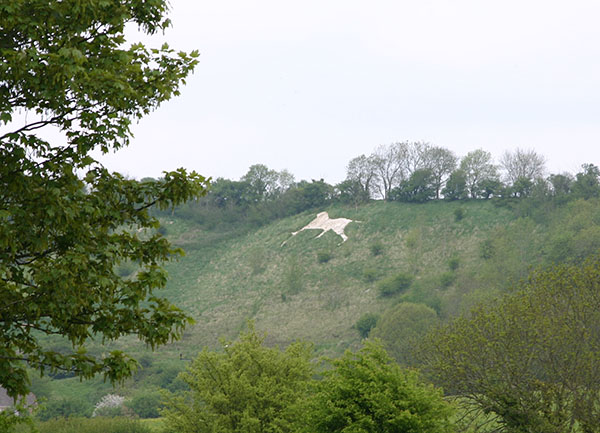
Broad Town White Horse
Cherhill White Horse's origins are not known, but it is thought to date to the mid-1700s. It may have been carved then to be associated with the loyalty of House of Hanover whose symbol was a white horse. It may have also been older and created to commemorate a battle in 878. It is also being attributed to being cut in 1780 with a design inspired by artist George Stubbs, who painted horses. In the 1800s, a local farmer had placed glass bottles into the ground to give the horse a sparkling eye; these disappeared and were re-added in the 1970s and disappeared again. Today, stones mark its eye. The horse was lit up to commemorate the new king and queen in 1937 (King George and his queen Elizabeth). The hillside now belongs to the National Trust.

Cherhill White Horse
Hackpen White Horse is also called Broad Hinton White Horse, and its origin is not exactly known, but it was thought to have been carved in 1838 to commemorate the coronation of Queen Victoria. There is parking on the top of the hill to visit the horse, and real horses do live in the fields around it. This area is probably noted for the saying "chalk and cheese", where the hills here were chalk but the ones on the other side of clay and popular for cattle grazing to create milk for cheese. The horse was scoured two years before I took the below photograph, and it looks in need. The next time it was scoured was 2011 and then in 2012, and the horse was illuminated afterwards. In 2009, red fabric was covered over the chalk for the Red Nose Day charity.

Hackpen White Horse
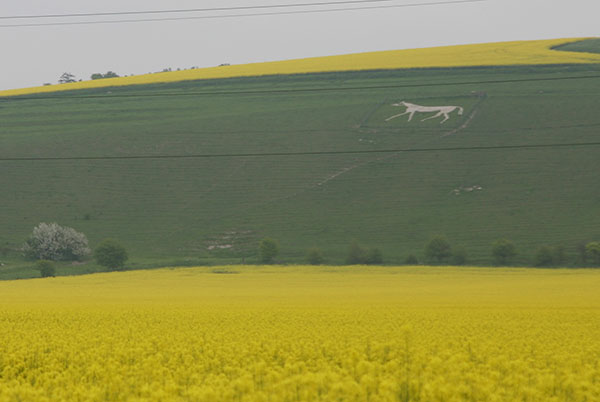
Pewsey White Horse
Westbury White Horse (Bratton White Horse) is the first white horse I had seen as it can be seen from the train and from a good distance across the valley. The white horse lies next to an Iron Age fort. The horse was re-scoured in 1778, and it was thought to have oblitrated another white horse on the spot, although no records exist of this. It is a symbol of Westbury near where it is located and can be seen for miles. Unfortunately, the origins are not clear as to why it exists, but it may have been the 878 battle or the House of Hanover. Legend has it that the white horse comes to life at midnight and goes down the hill to drink in the springs. Like other white horses, it was illuminated. It was illuminated by army equipment in 1900 and then again in 1950, and it brought traffic to a standstill. In the 1950s, concrete was poured over the horse to maintain it. In 2003, an anti-war message was sprayed onto the horse. A couple of months after I took the photograph below, the horse was cleaned and then illuminated again once repairs finished. In 2010, "wonkey" was written on the neck of the horse and re-cleaned. In 2012, the horse was cleaned again for the Diamond Jubilee and the Olympics, and this time, it was illuminated with different colours. Its latest clean was 2018. This is one of the most popular white horses and has appeared in film and books and in artwork, and it is a local symbol.

Westbury White Horse
Alton Barnes white horse was cut in 1812 near Alton, Wiltshire. It was designed by an artist, and it is the second largest white horse in Wiltshire. Ever winter solstice, it is illuminated with candles, and it was illuminated in 2012 during its 200th birthday. It has been transformed into a zebra in the past, and it can be viewed for miles. On a clear day, it is said to be visible from Old Sarum. It is located near an Iron Age fort and long barrow. The artist who was meant to have carved the horse conned the landowner and got someone else to do it, and he demanded payment; the artist was later hanged for other crimes. In 2004, the horse was re-scoured but with chalk from a pit near the horse so chalk would not have to be transported, and this is visible and was a mistake. The horse was covered during World War II. When the horse is re-scoured, care must be taken as it is an area of protection. The horse was used in music videos. The horse has been met with a fair amount of pranks at being turned into a zebra and gaining an extra "limb".

Alton Barnes
The Uffington White Horse is located in Oxfordshire and on the edge of Wiltshire. It is the oldest white horse and dates from the 1000n B.C., and it is located near an ancient hill fort and not far from ancient tombs. I recently saw it earlier this summer, and it had been re-scoured earlier in the year. I think it looks more like a cat than a white horse because the body is long with a long tail and whiskers, but it is apparently a stylised horse and has a similar design to white horse carvings of the time. I think it would be amazing if it was indeed a white cat instead of a white horse. The white horse is very difficult to photograph because the hill is very eroded. It is best photographed from the air. This white horse has been mentioned in books, music, and in videos.
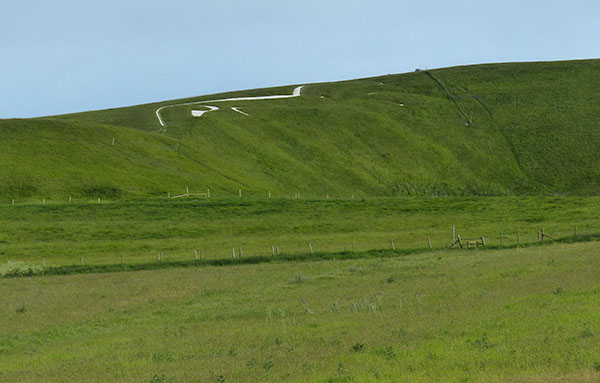
Uffington White Horse
If you have never completed a White Horse Road Tour (of Wiltshire), then I recommend it. Make it a day and have a nice stop at a country pub; you can even make a trip to see Avebury stone circle.
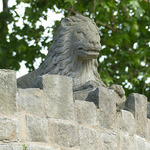

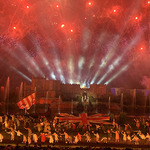
Leave a comment